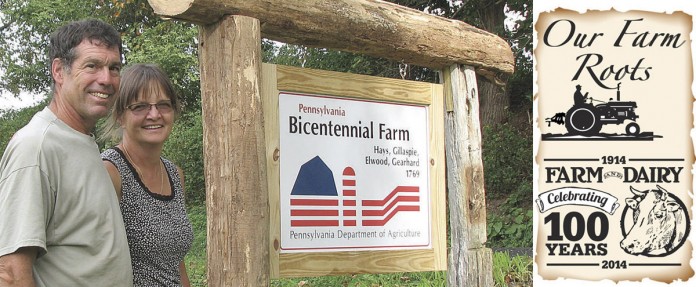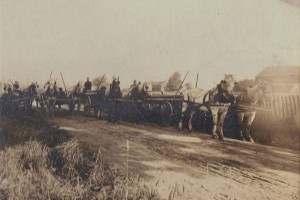
By ROSE MCCHESNEY
MURRYSVILLE, Pa. — Nearly 250 years of family ancestry, local legend, historical records and funny anecdotes tell a story of a family’s love for their land.
Herb and Nancy Gearhard, the current operators of the family-owned farm in Westmoreland County, Pennsylvania, have enjoyed exploring the heritage of their ancestors’ farm.
Early years sketchy
They knew some details as far back as Herb’s grandfather, but when they started pursuing bicentennial certification last year, they began to research more thoroughly. And they have found a treasure trove of information.
Herb got a copy of the History of the County of Westmoreland Pennsylvania that filled in some information beyond the collection of family photographs and other documents.
It all started in 1769, when Robert Hays purchased 339.5 acres of land about 20 miles east of Pittsburgh for 45 pounds, 2 shillings and sixpence. That’s right: They paid with British money.
Then, Robert and one of his children were kidnapped by Indians and held for three years. After they returned home, the boy often roamed the woods, hunting and fishing. Later, the Indians raided the farm, and Robert was killed in the doorway of the original homestead.
No one knows exactly where that home was. A later generation built another house on the property, and that foundation is still there — with a corn crib on top of it.
Following Robert’s death, his daughter Mary Margaret, and her husband, William Gillaspie, took over the farm.
This is one aspect of the farm’s history that was fascinating to Herb and Nancy: It wasn’t always the sons who carried on the family farm.
“That’s why there are four names on our sign,” Herb explained.
Robert didn’t have a will, so in September of 1794, his three children had to petition the Orphan’s Court for ownership of the farm. When the children were awarded the property, it was split among them, thus beginning the downsizing of the original farm property.
Mary Margaret and William had all daughters, two of whom married brothers from the Elwood family. When one of their daughters, Ann, passed away, their son-in-law moved away and left his two boys to be raised by Mary Margaret and William. William G. was one of those boys, and he became the fourth generation of farmers on the family farm.
William G. Elwood and his brother had to petition the Orphan’s Court in the early 1830s for ownership of the farm after their grandparents passed away, since their father wasn’t around.
Early oil boom
William G. had four children. One of them was A.P., and he took over the farm next.
One interesting piece of local history that put Murrysville on the map took place in 1878 during A.P. Elwood’s ownership just a few miles from the farm. A crew was drilling for oil, and hit a gas pocket, and the derrick exploded.
People came from miles away to see the phenomenon. And then someone got a little too close with their lantern and the raw gas caught on fire. That original flame was said to have been seen from 20 miles away in Pittsburgh. It took about a year and a half, but they finally extinguished the flame. This particular well ended up as one of the world’s most productive.

Of A.P.’s four children — Cora, Glen, Vern and Roy — Glen took over the farm next. He was highly skilled in driving teams of horses and threshing grain, and at one time had 12 teams of horses during the original teamsters’ union era.
Glen was hired to use his teams to haul pipe for constructing the natural gas pipelines. He hired 11 other men to drive his teams to meet this demand. When the gas boom slowed down, he returned to farming full time.
Tragedy and loss
In the early 1900s, Glen Elwood and his father, A.P., each built a house on the property. A.P. died in 1919, and then in 1920, Glen was in a threshing accident and his arm was severed at the shoulder. He was taken to the hospital, but died from the blood loss.
His widow left the house Glen had built for her and went back to her family. Since the house was vacant, she put it up for sale, and the local blacksmith bought it, and raised a son and two daughters in that brick house.
There was no one left to run the farm, so Glen’s brother Roy returned from pursuing a career as a lawyer in California to take over the family homestead.
Back in Pennsylvania, he married a girl he knew from school here, and started farming where his brother left off. A daughter, Herb Gearhard’s mother, was born in 1922.
Roy focused his farming mainly on poultry, eggs, and milk. Today, a sign in the front yard announces the farm’s position as a bicentennial farm, and the post nearest the road is the post on which a sign hung when Herb’s grandparents would advertise their eggs, chickens and milk for sale. Herb and Nancy opted to keep that little piece of history when they added a second post and hung the new sign.
Roy and Ern, the blacksmith, became great friends and did many farming activities together. Ern’s son and Roy’s daughter, Jane, were the same age, so the two walked to school together along with siblings and cousins each day for eight years. They courted briefly, but it didn’t work out. (That’s really good news for today’s generation, because that blacksmith was Nancy Gearhard’s grandfather.)
Farm transitions
Herb’s mother, Jane, was the next generation to farm the land. She had studied to be a teacher, and got a teaching job straight out of college at Franklin Township, where she had attended school.
There was a vacancy teaching math, and while her specialty was biology, she agreed to help cover until they hired a math teacher. And when they hired the new math teacher, a WWII Marine and recent college graduate, they fell in love. And he fell in love with the farm.
Jane Elwood and John Gearhard were married, and Jane was forced out of her teaching position because there were rules against spouses working in the same building. They relocated her to another building, but she decided instead to stay home and raise a family.
John and Jane raised their family of five children in the house that A.P. built, the current farmhouse. Jane and John tried to milk cows, but he found it challenging to milk and then go off to school to teach. So after eight years of milking, they converted to beef production.
When he retired from teaching, they got out of beef altogether and focused on truck farming, raising vegetables and to sell at local farmers markets.
Present ownership
Nancy would come to the farm to visit her grandfather, the blacksmith, so she and Herb knew of each other even as little children. When her grandfather died, and she was a senior in high school, her family built a home not too far away from the Gearhard farm on part of the farm the blacksmith purchased.
As young adults, and living near each other, Herb and Nancy got to know each other better, and eventually married.
Herb Gearhard transitioned out of vegetables, and started making hay and some small grains, and works as a mechanic at the steel mill. Seventy-five of the farm’s 150 acres are tillable.
Ellen, one of Herb’s sisters, also lives on the farm. “She’s right there helping unload hay when I need it!” Herb added.
Corn maze

In addition to the hay, grains, and the animals they have, the Gearhards have operated a 2.5 acre corn maze for 15 years. The farm’s ninth generation — Herb and Nancy’s son, Michael, and daughter, JoElla — have been involved with the maze since its inception, and hope to continue with that in the future.
Aerial views of the past 14 years of mazes are viewable on the maze website (gearhardfarms.com), including last year’s maze which was designed to celebrate the bicentennial farm status.
Farm legacy
Herb and Nancy have loved learning about the roots their family has on the farm. And some of the roots are still visible, like the barn that’s about 200 years old, with hand-hewn beams and hand-cut boards.

“Dad had given up on it,” Herb said, “but after he passed, I just couldn’t stand to see it keep getting worse and worse.
“I thought there was enough good that we could eliminate some of the additions from over the years, and bring the original structure back to life.”
And an Amish crew did just that in 2001.
“We want this land to be preserved,” they explained. “We want to do everything we can to protect it for future generations.”
The land split off a few times, so instead of 339 acres, there are 150 now, and the chosen production may look different than it did in 1769. But the roots remain, and so does the love of the land, and the love of family.











Fascinating!
Over the centuries, the continuity is astounding to me.
It all boils down to two words: “HARD WORK” and those ancient relatives and families rose to the occasion and were up to the task. Now THAT’S AMERICA!
Keep it up and pass it on!
Hi Herb and Nancy! Very well written article including a very nice picture of you both! The Gearhard Farm is a real piece of history in Westmoreland, Murrysville. Have to copy this one!
Congratulations!
Carol
Hello, I am the Great Gran Daughter of William Weinal Cline and Rachel Anderson Hill Cline. My Great Grand Parents farm was handed Down to their son, Park Rush Cline. Are there any pictures of the “Cline Farm” on Cline Hollow Road? I am also under the impression that my Great Grand Father had something to do with the “Reformed Church” in the area. If you could point me in the right direction to find information, I would be grateful.